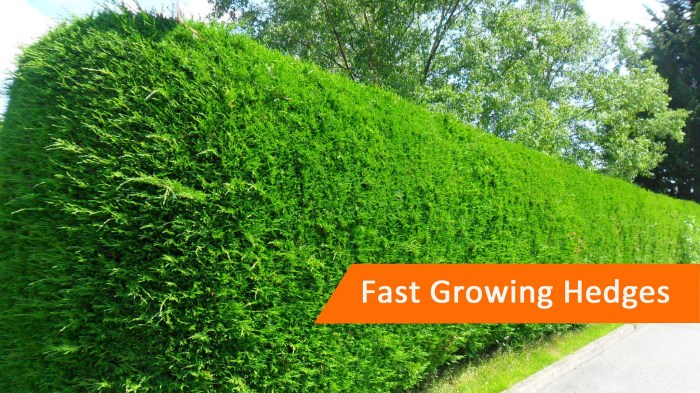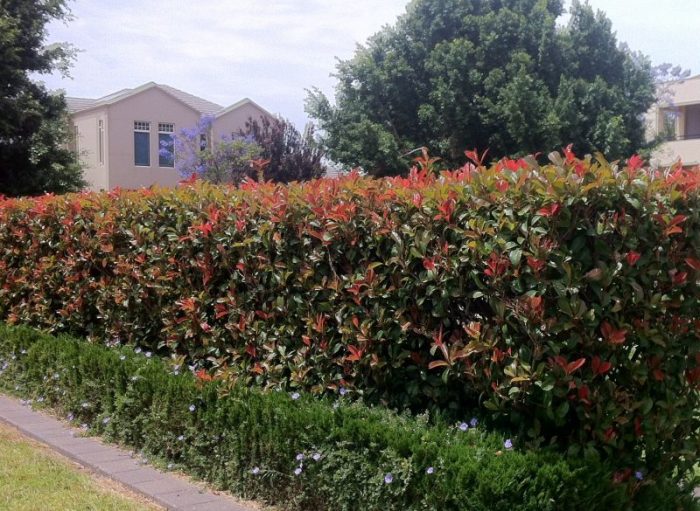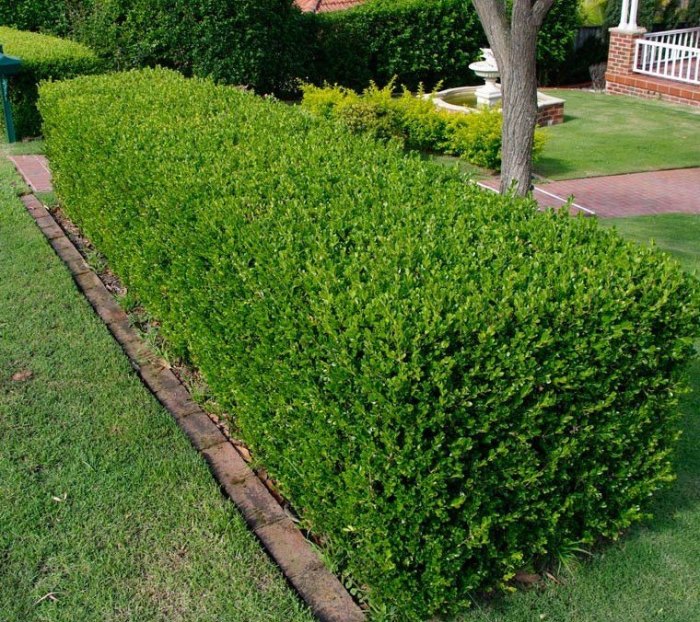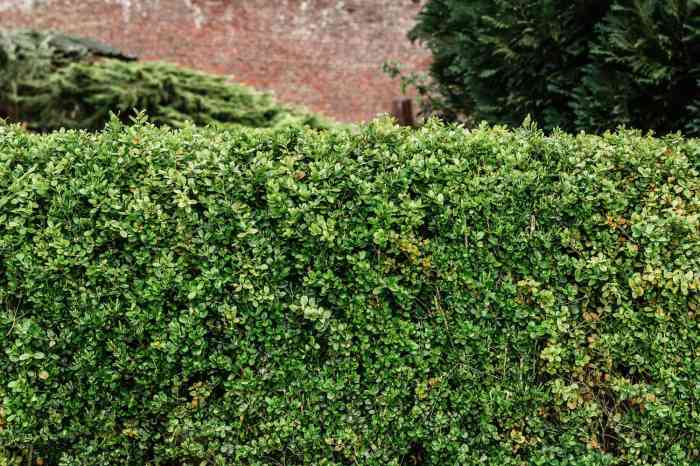Intruder proof hedge plants are more than just a decorative element; they serve as a vital component of home security, creating a natural barrier that deters unwanted visitors. These hardy plants, with their dense foliage, thorny branches, and robust growth, offer a formidable line of defense, making your property less appealing to potential intruders.
This guide explores the world of intruder proof hedges, delving into the selection, planting, maintenance, and integration of these security-enhancing plants. From understanding the benefits of using hedges for security to choosing the right plants for your specific needs, we’ll cover everything you need to know to create a natural fortress around your home.
Introduction to Intruder-Proof Hedges: Intruder Proof Hedge Plants

Intruder-proof hedges are a vital element in enhancing the security of residential and commercial properties. They act as a physical barrier, deterring potential intruders and providing an extra layer of protection. These hedges are strategically planted to create a dense and impenetrable barrier, making it difficult for individuals to access the property without being noticed.Hedges offer several benefits for security purposes.
They create a natural visual barrier, making it harder for intruders to see what is happening inside the property. This concealment can discourage potential criminals from attempting to gain entry. Additionally, hedges provide a physical obstacle, making it more difficult for intruders to breach the perimeter.
The dense foliage and thorny branches can slow down or deter intruders, giving residents time to react or alert authorities.
Common Intruder-Proof Hedge Plants
Choosing the right plants for an intruder-proof hedge is crucial. Some common species known for their dense growth, thorny branches, and ability to deter intruders include:
- Hawthorn (Crataegus):This thorny native species is a popular choice for security hedges. Its dense foliage and sharp thorns make it difficult to penetrate.
- Holly (Ilex):Holly is another excellent option, known for its prickly leaves and dense growth habit. It can be pruned into a variety of shapes, creating a formidable barrier.
- Pyracantha (Firethorn):This evergreen shrub features dense foliage and sharp thorns. Its bright red berries add a decorative touch, while the thorns provide a formidable deterrent.
- Berberis (Barberry):This genus includes several species with thorny branches and dense foliage, making them ideal for security hedges. They also produce attractive flowers and berries.
- Blackthorn (Prunus spinosa):This native species is known for its dense growth habit and sharp thorns. It is a hardy and resilient plant, making it suitable for various climates.
Planting and Maintaining Intruder-Proof Hedges

Planting and maintaining intruder-proof hedges effectively requires careful planning and consistent care. Understanding the right techniques for planting, pruning, and ensuring their health is crucial for maximizing their security benefits and longevity.
Planting Intruder-Proof Hedges
Planting intruder-proof hedges involves several steps to ensure their successful establishment and growth. The process starts with selecting the right location and preparing the soil.
- Site Selection:Choose a location with adequate sunlight exposure and well-drained soil. Consider the mature size of the hedge and ensure there is sufficient space for its growth. Avoid planting near structures or utilities that could be damaged by roots.
- Soil Preparation:Dig a trench about 12 inches wide and deep enough to accommodate the roots of the plants. Amend the soil with compost or other organic matter to improve drainage and nutrient content.
- Planting:Space the plants according to their recommended spacing. Place the root ball in the trench and backfill with soil, ensuring the root flare (where the roots meet the trunk) is above ground level. Water thoroughly after planting.
Pruning and Trimming Intruder-Proof Hedges
Regular pruning and trimming are essential for maintaining the shape, density, and security of intruder-proof hedges. Proper techniques ensure optimal growth and deter unwanted access.
- Initial Pruning:After planting, prune the hedges to encourage branching and a dense growth habit. This helps create a more impenetrable barrier.
- Regular Trimming:Trim the hedges regularly, usually 2-3 times a year, to maintain their desired shape and height. Avoid over-pruning, as this can weaken the plants and make them more susceptible to disease.
- Hedge Shape:Consider the desired shape of the hedge. A slanted or angled top can deter climbing and provide better visibility. A rounded shape is more aesthetically pleasing but might require more frequent trimming.
Ensuring Health and Longevity
Maintaining the health and longevity of intruder-proof hedges is essential for their effectiveness.
- Watering:Water the hedges regularly, especially during dry periods. Deep watering is more beneficial than frequent shallow watering.
- Fertilizing:Fertilize the hedges in spring and fall to provide essential nutrients for growth. Use a balanced fertilizer formulated for shrubs or hedges.
- Disease and Pest Control:Monitor the hedges for signs of disease or pests. Treat any issues promptly to prevent further damage.
Enhancing Security with Hedges

Hedges are an effective way to enhance the security of your property. They can be used to create natural barriers that deter intruders, making it more difficult for them to gain access to your home or business. When integrated with other security measures, hedges can significantly improve your overall security.
Integrating Hedges with Other Security Measures
Hedges can be integrated with various security measures to create a comprehensive security system. By combining the natural barrier of a hedge with other security features, you can create a more robust and effective defense against intruders.
- Motion Sensor Lights:Installing motion sensor lights along the perimeter of your property, especially near hedges, can deter intruders by illuminating the area when movement is detected. The sudden bright light can startle potential intruders and alert you to their presence.
- Security Cameras:Placing security cameras strategically near hedges allows you to monitor activity around your property. Cameras can record footage of intruders attempting to breach your hedge, providing valuable evidence for law enforcement. Additionally, the presence of cameras can deter intruders who are aware of their recording capabilities.
- Security Systems:Integrating your hedge with a security system can enhance its effectiveness. Motion sensors placed near the hedge can trigger an alarm when someone attempts to breach it, alerting you and authorities to the intrusion. You can also use the security system to control outdoor lighting, further deterring intruders.
- Fencing:Combining a hedge with a fence creates a double barrier that is difficult to penetrate. The hedge can provide additional concealment and deter intruders from attempting to climb over the fence. It also serves as a natural deterrent, making the fence less appealing to potential intruders.
Creating Natural Barriers with Hedges
Hedges can create natural barriers that make it more difficult for intruders to access your property. By strategically planting hedges, you can create a dense, impenetrable barrier that discourages intrusion attempts.
- Dense and Tall Hedges:Opt for hedge plants that grow densely and reach a significant height. This creates a formidable barrier that is difficult to see through and climb over. For example, a dense hedge of holly bushes can reach heights of 10 feet or more, making it a formidable obstacle for intruders.
- Layered Hedges:Create a layered hedge by planting different species of plants with varying heights and densities. This creates a more complex barrier that is difficult to navigate. For instance, you could plant a row of tall evergreens at the back of the property, followed by a row of thorny shrubs and a row of low-growing groundcover plants.
- Thorny Hedges:Thorny hedges can deter intruders by creating a painful and difficult barrier to penetrate. Plants like barberry, hawthorn, and blackthorn have sharp thorns that can discourage anyone from attempting to climb or force their way through them.
- Strategic Placement:Place hedges strategically around your property to create natural barriers in vulnerable areas. For example, plant a hedge around your perimeter fence to create an additional layer of protection. You can also use hedges to block access to windows and doors, making it more difficult for intruders to gain entry.
Using Lighting and Surveillance Systems to Complement Hedges
Lighting and surveillance systems can be used to complement hedges and enhance their effectiveness as security measures. By strategically placing lights and cameras, you can improve visibility around your property and deter intruders.
- Motion Sensor Lights:Install motion sensor lights along the perimeter of your property, especially near hedges. The sudden bright light can startle potential intruders and alert you to their presence.
- Security Cameras:Place security cameras strategically near hedges to monitor activity around your property. Cameras can record footage of intruders attempting to breach your hedge, providing valuable evidence for law enforcement. Additionally, the presence of cameras can deter intruders who are aware of their recording capabilities.
- Night Vision Cameras:For enhanced security at night, consider using night vision cameras. These cameras allow you to monitor your property even in low-light conditions, providing valuable footage of any intrusion attempts. Night vision cameras can be particularly effective in areas where hedges block natural light.
- Floodlights:Install floodlights along the perimeter of your property, focusing on areas near hedges. Floodlights provide bright illumination, deterring intruders and making it easier for you to see what’s happening around your property.
Common Mistakes to Avoid

Planting and maintaining an intruder-proof hedge requires careful planning and consistent effort. Neglecting crucial aspects can compromise the hedge’s effectiveness and potentially lead to security vulnerabilities. Understanding common mistakes and implementing preventative measures is vital for ensuring the hedge’s integrity and maximizing its security benefits.
Choosing the Wrong Plant Species
Selecting the appropriate plant species is crucial for an effective intruder-proof hedge. Choosing a species that is not well-suited to the local climate or soil conditions can lead to poor growth, disease susceptibility, and ultimately, a weak hedge.
- Climate and Soil Compatibility:Consider the plant’s tolerance to the local climate, including temperature extremes, rainfall, and soil type. Choose species that thrive in your specific conditions.
- Growth Rate and Density:Opt for fast-growing species that develop a dense, impenetrable barrier quickly. Slow-growing species may take years to reach a sufficient height and density.
- Thorns and Spines:Incorporate species with thorns or spines for added deterrence. However, ensure these plants are not too aggressive or invasive.
Improper Planting Techniques
Planting techniques significantly influence the hedge’s health and longevity. Incorrect planting practices can lead to stunted growth, susceptibility to diseases, and ultimately, a weak and ineffective barrier.
- Planting Depth:Plant the seedlings at the appropriate depth, ensuring the root ball is covered with soil while the crown remains exposed. Planting too deep can suffocate the roots, while planting too shallow can leave them vulnerable to drying out.
- Spacing:Ensure adequate spacing between plants to allow for proper growth and air circulation. Overcrowding can lead to competition for resources and disease susceptibility.
- Watering:Establish a consistent watering schedule, especially during the initial establishment phase. Adequate watering is essential for healthy root development and growth.
Neglecting Pruning and Maintenance, Intruder proof hedge plants
Regular pruning and maintenance are crucial for maintaining the hedge’s shape, density, and overall health. Neglecting these tasks can lead to overgrown and unkempt hedges, compromising their security effectiveness.
- Regular Pruning:Prune the hedge regularly to maintain its desired shape and density. This encourages new growth and prevents the hedge from becoming too thick and unmanageable.
- Deadwood Removal:Remove any dead or diseased branches to prevent the spread of infections and maintain the hedge’s overall health.
- Fertilization:Provide adequate fertilization to ensure the hedge receives the necessary nutrients for optimal growth and health.
Ignoring Pests and Diseases
Pests and diseases can weaken the hedge, making it susceptible to damage and compromising its security effectiveness. Ignoring pest and disease problems can lead to widespread infestation and ultimately, a decline in the hedge’s health.
- Pest Control:Regularly inspect the hedge for signs of pest infestations and implement appropriate control measures. This may involve using natural pest control methods or applying pesticides, depending on the specific pest.
- Disease Management:Monitor the hedge for signs of diseases, such as leaf discoloration, wilting, or fungal growth. Take prompt action to address any disease issues, which may involve pruning infected branches, applying fungicides, or improving drainage.
Lack of Adequate Security Measures
While a well-maintained hedge provides a significant deterrent, relying solely on it for security can be insufficient. Combining the hedge with other security measures is crucial for a comprehensive security system.
- Motion Sensors:Install motion sensors along the perimeter to detect any movement near the hedge and trigger alarms or activate security cameras.
- Security Cameras:Deploy security cameras to monitor the hedge and surrounding areas, providing visual evidence of any intrusion attempts.
- Lighting:Adequate lighting around the hedge can deter intruders and improve visibility, making it easier to detect suspicious activity.
Conclusion

By understanding the principles of intruder-proof hedges, you can create a natural barrier that complements your existing security measures, enhancing your property’s protection and giving you peace of mind. Remember, a well-maintained, strategically designed hedge can act as a formidable deterrent, making your home a less attractive target for intruders.